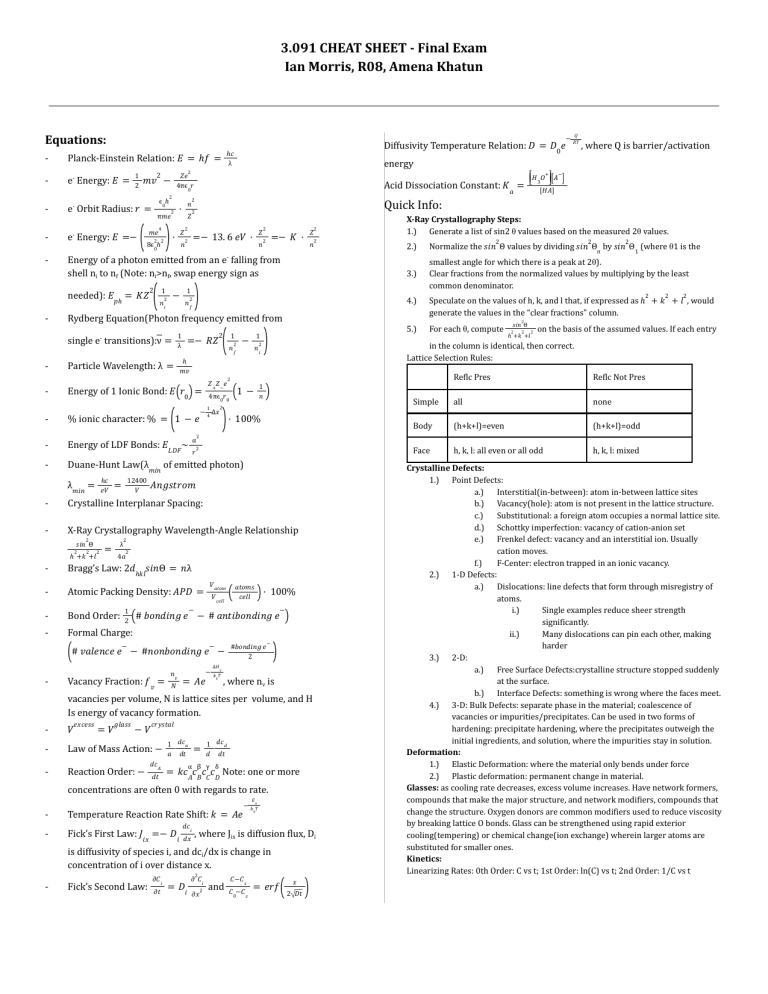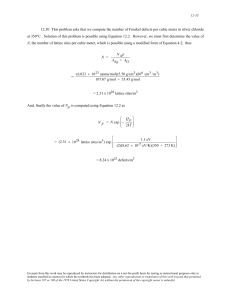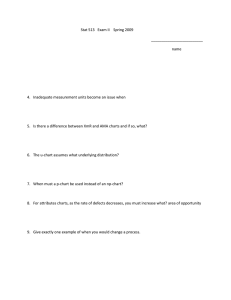
3.091 CHEAT SHEET - Final Exam Ian Morris, R08, Amena Khatun 𝑄 Equations: − 𝑅𝑇 - Planck-Einstein Relation: 𝐸 = ℎ𝑓 = - e- Energy: 𝐸 = 1 2 - e- Energy: 𝐸 =− ϵ0ℎ 2 ( ) 4 - 𝑚𝑒 2 2 8ϵ0ℎ 2 2 𝑍 · 2 =− 𝐾 · 2 𝑛 𝑍 2 𝑛 Energy of a photon emitted from an e falling from shell ni to nf (Note: ni>nf, swap energy sign as ( 2 1 2 𝑛𝑖 − ) 1 2 𝑛𝑓 [ ] X-Ray Crystallography Steps: 1.) Generate a list of sin2 θ values based on the measured 2θ values. ( 2 single e transitions):ν = 1 λ - Particle Wavelength: λ = ℎ 𝑚𝑣 - Energy of 1 Ionic Bond: 𝐸 𝑟0 = =− 𝑅𝑍 1 2 ( 4πϵ0𝑟0 ) − 2 𝑛𝑓 𝑍+𝑍−𝑒 ( ) 1 2 𝑛𝑖 ( 1 𝑛 1− ) % ionic character: % = 1 − 𝑒 2 2 Normalize the 𝑠𝑖𝑛 Θ values by dividing 𝑠𝑖𝑛 Θ𝑛 by 𝑠𝑖𝑛 Θ1 (where θ1 is the 3.) smallest angle for which there is a peak at 2θ). Clear fractions from the normalized values by multiplying by the least common denominator. 2 2 2 4.) Speculate on the values of h, k, and l that, if expressed as ℎ + 𝑘 + 𝑙 , would generate the values in the “clear fractions” column. 5.) For each θ, compute 2 𝑠𝑖𝑛 Θ 2 2 2 ℎ +𝑘 +𝑙 on the basis of the assumed values. If each entry in the column is identical, then correct. Lattice Selection Rules: ) 2 1 − 4 ∆𝑥 2 2.) Rydberg Equation(Photon frequency emitted from - - 2 𝑍 =− 13. 6 𝑒𝑉 · 𝑛 ⎡⎢𝐻 𝑂+⎤⎥ 𝐴− ⎣ 3 ⎦ [𝐻𝐴] Quick Info: 2 𝑍 - needed): 𝐸𝑝ℎ = 𝐾𝑍 - Acid Dissociation Constant: 𝐾𝑎 = 𝑛 · 2 π𝑚𝑒 , where Q is barrier/activation energy 𝑍𝑒 4πϵ0𝑟 2 e- Orbit Radius: 𝑟 = ℎ𝑐 λ 2 2 𝑚𝑣 − - Diffusivity Temperature Relation: 𝐷 = 𝐷0𝑒 · 100% Reflc Pres Reflc Not Pres Simple all none Body (h+k+l)=even (h+k+l)=odd Face h, k, l: all even or all odd h, k, l: mixed 2 α - Energy of LDF Bonds: 𝐸𝐿𝐷𝐹~ - Duane-Hunt Law(λ𝑚𝑖𝑛 of emitted photon) ℎ𝑐 𝑒𝑉 λ𝑚𝑖𝑛 = 12400 𝑉 = 2 𝑟 𝐴𝑛𝑔𝑠𝑡𝑟𝑜𝑚 - Crystalline Interplanar Spacing: - X-Ray Crystallography Wavelength-Angle Relationship 2 2 𝑠𝑖𝑛 Θ 2 2 2 ℎ +𝑘 +𝑙 λ = 2 4𝑎 - Bragg’s Law: 2𝑑ℎ𝑘𝑙𝑠𝑖𝑛Θ = 𝑛λ - Atomic Packing Density: 𝐴𝑃𝐷 = - Bond Order: - Formal Charge: − - 𝑉𝑐𝑒𝑙𝑙 ( 𝑎𝑡𝑜𝑚𝑠 𝑐𝑒𝑙𝑙 ) · 100% (# 𝑏𝑜𝑛𝑑𝑖𝑛𝑔 𝑒− − # 𝑎𝑛𝑡𝑖𝑏𝑜𝑛𝑑𝑖𝑛𝑔 𝑒−) 1 2 (# 𝑣𝑎𝑙𝑒𝑛𝑐𝑒 𝑒 𝑉𝑎𝑡𝑜𝑚 − − − #𝑛𝑜𝑛𝑏𝑜𝑛𝑑𝑖𝑛𝑔 𝑒 − Vacancy Fraction: 𝑓𝑣 = 𝑛𝑣 𝑁 − = 𝐴𝑒 #𝑏𝑜𝑛𝑑𝑖𝑛𝑔 𝑒 2 ) ∆𝐻𝑣 𝑘𝑏𝑇 , where nv is vacancies per volume, N is lattice sites per volume, and H Is energy of vacancy formation. 𝑒𝑥𝑐𝑒𝑠𝑠 𝑔𝑙𝑎𝑠𝑠 =𝑉 𝑐𝑟𝑦𝑠𝑡𝑎𝑙 - 𝑉 −𝑉 - Law of Mass Action: − - Reaction Order: − 𝑑𝑐𝐴 𝑑𝑡 1 𝑑𝑐𝑎 𝑎 𝑑𝑡 = 1 𝑑𝑐𝑑 𝑑 𝑑𝑡 α β γ δ = 𝑘𝑐𝐴𝑐𝐵𝑐𝐶𝑐𝐷 Note: one or more concentrations are often 0 with regards to rate. 𝐸 - − 𝑘 𝑎𝑇 Temperature Reaction Rate Shift: 𝑘 = 𝐴𝑒 Fick’s First Law: 𝐽𝑖𝑥 =− 𝐷𝑖 𝑑𝑐𝑖 𝑑𝑥 𝑏 , where Jix is diffusion flux, Di is diffusivity of species i, and dci/dx is change in concentration of i over distance x. - Fick’s Second Law: ∂𝐶𝑖 ∂𝑡 2 = 𝐷𝑖 ∂ 𝐶𝑖 2 ∂𝑥 and 𝐶−𝐶𝑠 𝐶0−𝐶𝑠 ( ) = 𝑒𝑟𝑓 𝑥 2 𝐷𝑡 Crystalline Defects: 1.) Point Defects: a.) Interstitial(in-between): atom in-between lattice sites b.) Vacancy(hole): atom is not present in the lattice structure. c.) Substitutional: a foreign atom occupies a normal lattice site. d.) Schottky imperfection: vacancy of cation-anion set e.) Frenkel defect: vacancy and an interstitial ion. Usually cation moves. f.) F-Center: electron trapped in an ionic vacancy. 2.) 1-D Defects: a.) Dislocations: line defects that form through misregistry of atoms. i.) Single examples reduce sheer strength significantly. ii.) Many dislocations can pin each other, making harder 3.) 2-D: a.) Free Surface Defects:crystalline structure stopped suddenly at the surface. b.) Interface Defects: something is wrong where the faces meet. 4.) 3-D: Bulk Defects: separate phase in the material; coalescence of vacancies or impurities/precipitates. Can be used in two forms of hardening: precipitate hardening, where the precipitates outweigh the initial ingredients, and solution, where the impurities stay in solution. Deformation: 1.) Elastic Deformation: where the material only bends under force 2.) Plastic deformation: permanent change in material. Glasses: as cooling rate decreases, excess volume increases. Have network formers, compounds that make the major structure, and network modifiers, compounds that change the structure. Oxygen donors are common modifiers used to reduce viscosity by breaking lattice O bonds. Glass can be strengthened using rapid exterior cooling(tempering) or chemical change(ion exchange) wherein larger atoms are substituted for smaller ones. Kinetics: Linearizing Rates: 0th Order: C vs t; 1st Order: ln(C) vs t; 2nd Order: 1/C vs t



